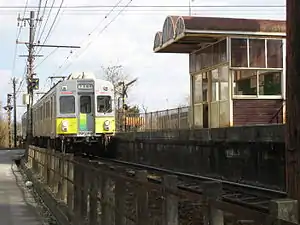Toyohashi Railroad Atsumi Line
The Toyohashi Railroad Atsumi Line (豊橋鉄道渥美線, Toyohashi Tetsudō Atsumi-sen) is a railway line in eastern Aichi Prefecture, Japan, operated by the private railway operator Toyohashi Railroad ("Toyotetsu"). The line runs from the centre of Toyohashi, traversing the centre of the Atsumi Peninsula, a largely rural district noted also for its hot spring resorts and marine sports as part of Mikawa Wan Quasi-National Park. The line is entirely within the cities of Toyohashi and Tahara.
| Toyohashi Railroad Atsumi Line | |
|---|---|
 A 1800 series EMU at Toshima Station in February 2007 | |
| Overview | |
| Locale | Aichi Prefecture |
| Termini | Shin-Toyohashi Mikawa Tahara |
| Stations | 16 |
| Service | |
| Type | Heavy rail |
| Operator(s) | Toyohashi Railroad |
| Rolling stock | 1800 series EMUs |
| History | |
| Opened | 22 January 1924 |
| Technical | |
| Line length | 18.0 km (11.2 mi) |
| Number of tracks | single |
| Track gauge | 3 ft 6 in (1,067 mm) |
| Electrification | 1,500 V DC overhead |
| Operating speed | 70 km/h (45 mph) |
Basic data
- Line length: 18.0 km (11.2 mi)
- Number of stations: 16
- Track: single
- Rail gauge: 1,067 mm (3 ft 6 in)
- Electrification: 1,500 V DC overhead
- Max speed: 70 km/h (45 mph)
- Railway signalling: Automatic (ATS, compatible with Meitetsu)
Operation
The northern terminal station for the Atsumi Line is located at Shin-Toyohashi Station. All trains run to the southern terminus at Mikawa Tahara Station at approximately 15 minute intervals. There are no express trains on the line.
Station list
| No. | Station name | Japanese | Distance from Shin-Toyohashi (km) |
Transfers | Location | |
|---|---|---|---|---|---|---|
| City | Prefecture | |||||
| 01 | Shin-Toyohashi | 新豊橋 | 0.0 | Toyohashi | Aichi | |
| 02 | Yagyu-bashi | 柳生橋 | 1.0 | |||
| 03 | Koike | 小池 | 1.7 | |||
| 04 | Aichidaigakumae | 愛知大学前 | 2.5 | |||
| 05 | Minami-Sakae | 南栄 | 3.2 | |||
| 06 | Takashi | 高師 | 4.3 | |||
| 07 | Ashihara | 芦原 | 5.3 | |||
| 08 | Ueta | 植田 | 6.3 | |||
| 09 | Mukougaoka | 向ヶ丘 | 7.1 | |||
| 10 | Ōshimizu | 大清水 | 8.5 | |||
| 11 | Oitsu | 老津 | 10.7 | |||
| 12 | Sugiyama | 杉山 | 12.7 | |||
| 13 | Yagumadai | やぐま台 | 14.0 | Tahara | ||
| 14 | Toshima | 豊島 | 15.6 | |||
| 15 | Kambe | 神戸 | 17.1 | |||
| 16 | Mikawa Tahara | 三河田原 | 18.0 | |||
Rolling stock

As of April 2015, the line is operated using a fleet of ten three-car 1800 series electric multiple unit (EMU) trains.[1] These trains were modified from former Tokyu 7200 series EMUs.[2] All trains are configured for One-man operation.
Since 2013, the trains are each painted a different colour and carry the names of flowers, as follows.[2]
| Set No. | Flower name | Colour |
|---|---|---|
| 1801 | Rose (ばら, Bara) | Red |
| 1802 | Hibiscus (はまぼう, Hamabou) | Brown |
| 1803 | Rhododendron (つつじ, Tsutsuji) | Red |
| 1804 | Sunflower (ひまわり, Himawari) | Blue |
| 1805 | Sweet flag (菖蒲, Shoubu) | Purple |
| 1806 | Magnolia (しでこぶし, Shidekobushi) | Light green |
| 1807 | Rape blossom (菜の花, Nanohana) | Yellow |
| 1808 | Camellia (椿, Tsubaki) | Green |
| 1809 | Cherry blossom (桜, Sakura) | Pink |
| 1810 | Chrysanthemum (菊, Kiku) | Orange |
History
The privately owned Atsumi Electric Railway (渥美電鉄, Atsumi Dentetsu) began operations on January 22, 1924 between Takashi and Toshima, electrified at 600 V DC. The line was extended to Kambe in March and to Mikawa Tahara by June 10 of the same year. In the opposite direction, the line was extended to Shin-Toyohashi by May 1925. On April 10, 1926, the now-defunct section of track from Mikawa Tahara to Kurokawahara was completed. Construction of a proposed extension to Fukue commenced in 1940, but was later abandoned due to material shortages in World War II.
On September 1, 1940, the Atsumi Electric Railway was merged into Nagoya Railway. Most of the stations on the line were closed on June 5, 1944, as an austerity measure. On October 1, 1954, the Toyohashi Railway was spun out from the Nagoya Railway as an independently operating subsidiary. Most of the closed stations were reopened by this time, but the section from Mikawa Tahara to Kurokawahara was closed permanently. Express train operations began from October 1, 1965.
All freight operations were discontinued from February 1, 1984 and express train operations were discontinued from September 1, 1985. On July 2, 1997 the electrification system was upgraded to 1,500 V DC.
See also
References
This article incorporates material from the corresponding article in the Japanese Wikipedia.
- 私鉄車両編成表 2015 [Private Railway Rolling Stock Formations - 2015] (in Japanese). Japan: Kotsu Shimbunsha. 23 July 2015. p. 92. ISBN 978-4-330-58415-7.
- Terada, Hirokazu (January 2016). 日本のローカル私鉄 30年前の残照を訪ねて その26 [Japan's rural private railways: Revisiting the afterglow of 30 years ago (Part 26)]. Japan Railfan Magazine (in Japanese). Vol. 56 no. 657. Japan: Koyusha Co., Ltd. pp. 112–117.
External links
| Wikimedia Commons has media related to Toyohashi Railroad. |
- Toyohashi Railroad official website (in Japanese)